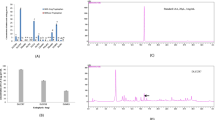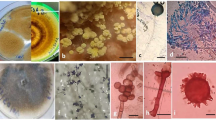Abstract
Cymbidium hybridum is one of the most popular pot orchids and cut flowers worldwide. However, the long vegetative growth period and the discordant blooming retarded its mass production. The mixotrophic nutritional mode of some chlorophyllous Cymbidium suggested the essential role of mycorrhizal fungi in the growth of adult green orchids. Here 34 root-associated endophytes were obtained from wild and cultivated Cymbidium and eight strains exhibited obvious growth-promoting effects on the C. hybridum plantlets with increasing root number, root diameter or new bud initiation. Among these, three isolates CL01, ZH3A-3 and CY5-1 with distinct cultural traits and colonization patterns showed better growth-promoting effects. Internal transcribed spacer sequence analyses and morphological observation revealed isolate CL01 belonged to Tulasnella-like Rhizoctonia, ZH3A-3, Umbelopsis nana and CY5-1, Scytalidium lignicola. Microscopic study showed isolate CL01 formed typical orchid mycorrhiza and isolate CY5-1 formed pseudo-mycorrhiza with orchid, whereas hyphae of isolate ZH3A-3 aggregated in the host velamen cells at regular intervals and caused the hypertrophied nucleus and aggregated cytoplasm of neighboring host cell. These three isolates significantly enhanced the increased percentage of total fresh weight of plantlets compared with un-inoculated control (83, 99 and 75 %, respectively). In addition, isolate CL01 increased the N, P, Zn, Cu, Fe contents and ZH3A-3 significantly improved K, Ca, Cu, Mn contents of the symbiotic plantlets compared with control. These results suggested that the mass production of C. hybridum and related orchids could be improved by different beneficial fungi from its parents.



Similar content being viewed by others
Abbreviations
- AM:
-
Arbuscular mycorrhziae
- DSE:
-
Dark septate endophytes
- ECM:
-
Ecto-mycorrhiza
- ITS:
-
Internal transcribed spacer
- IPFW:
-
Increased percentage of total fresh weight
- MS:
-
Murashige and Skoog basal medium
- MX:
-
Mixotrophy
- OMF:
-
Orchid mycorrhizal fungi
- PDA:
-
Potato dextrose agar
- 6-BA:
-
6-Benzyladenine
- NAA:
-
1-Naphthaleneacetic acid
- A.C.:
-
Activated carbon
References
Alexander C, Alexander IJ, Hadley G (1984) Phosphate uptake by Goodyera repens in relation to mycorrhizal infection. New Phytol 97:401–411
Amos RE, Barnett HL (1966) Umbelopsis versiformis, a new genus and species of the imperfects. Mycologia 58:805–808
Bagde US, Prasad R, Varma A (2010) Interaction of Mycobiont: Piriformospora indica with medicinal plants and plants of economic importance. Afr J Biotechnol 9(54):9214–9226
Bidartondo MI, Burghardt B, Gebauer G, Bruns TD, Read DJ (2004) Changing partners in the dark: isotopic and molecular evidence of ectomycorrhizal liaisons between forest orchids and trees. Proc R Soc B 271:1799–1806
Bougoure JJ, Bougoure DS, Cairney JW, Dearnaley JD (2005) ITS-RFLP and sequence analysis of endophytes from Acianthus, Caladenia and Pterostylis (Orchidaceae) in southeastern Queensland. Mycol Res 109:452–460
Cameron DD, Leake JR, Read DJ (2006) Mutualistic mycorrhiza in orchids: evidence from plant–fungus carbon and nitrogen transfers in the green-leaved terrestrial orchid Goodyera repens. New Phytol 171:405–416
Cameron DD, Irene J, Jonathan RL, David JR (2007) Mycorrhizal acquisition of inorganic phosphorus by the green-leaved terrestrial orchid Goodyera repens. Ann Bot 99:831–834
Cameron DD, Johnson I, Read DJ, Leake JR (2008) Giving and receiving: measuring the carbon cost of mycorrhizas in the green orchid, Goodyera repens. New Phytol 180:176–184
Chang DCN, Chou LC (2001) Seed germination of Haemaria discolor var. dawsoniana and the use of mycorrhizae. Symbiosis 30:29–40
Chang DCN, Chou LC (2007) Growth responses, enzyme activities, and component changes as influenced by Rhizoctonia Orchid mycorrhiza on Anoectochilus formosanus Hayata. Bot 48:446–451
Dearnaley JDW, Martos F, Selosse MA (2012) Orchid mycorrhizas: molecular ecology, physiology, evolution and conservation aspects. In: Hock B (ed) Fungal associations. The Mycota IX, 2nd edn. Springer, Berlin, pp 207–224
Dijk E, Eck ND (1995) Effects of mycorrhizal fungi on in vitro nitrogen response of some Dutch indigenous orchid species. Can J Bot 73:1203–1211
Dong F (2008) Screen several orchid mycorrhizal fungi and preliminary test on the seed germination condition. Dissertation, Beijing Forestry University, China
Dong F, Zhao JN, Liu HX (2008) Effects of fungal elicitors on the growth of the tissue culture of Cymbidium goeringii. North Hortic 5:194–196 In Chinese with english abstract
Fernando AA, Currah RS (1996) A comparative study of the effects of the root endophytes Leptodontidium orchidicola and Phialocephala fortinii (fungi imperfecti) on the growth of some subalpine plants in culture. Can J Bot 74:1071–1078
Gebauer G, Meyer M (2003) 15N and 13C natural abundance of autotrophic and mycoheterotrophic orchids provides insight into nitrogen and carbon gain from fungal association. New Phytol 160:209–223
Genre A, Chabaud M, Timmers T, Bonfante P, Barker DG (2005) Arbuscular mycorrhizal fungi elicit a novel intracellular apparatus in Medicago truncatula root epidermal cells before infection. Plant Cell 17:3489–3499
Girlanda M, Segreto R, Cafasso D, Liebel HT, Rodda M, Ercole E, Cozzolino S, Gebauer G, Perotto S (2011) Photosynthetic Mediterranean meadow orchids feature partial mycoheterotrophy and specific mycorrhizal associations. Am J Bot 98(7):1148–1163
Guo SX, Hou XQ (2009) Interaction between a dark septate endophytic isolate from Dendrobium sp. and roots of D. nobile seedlings. J Integr Plant Biol 51(4):374–381
Hossain MM, Kant R, Van PT, Winarto B, Zeng SJ, Teixeira DSJA (2013) The application of biotechnology to orchids. Crit Rev Plant Sci 32(2):69–139
Huynh TT, Thomson R, Mclean CB, Lawrie AC (2009) Functional and genetic diversity of myorrhizal fungi from single plants of Caladenia formosa (Orchidaceae). Ann Bot 104(4):757–765
Ihrmark K, Bodeker IT, Cruz-Martinez K, Friberg H, Kubartova A, Schenck J, Strid Y, Stenlid J, Brandstrom-Durling M, Clemmensen KE, Lindahl BD (2012) New primers to amplify the fungal ITS2 region—evaluation by 454-sequencing of artificial and natural communities. FEMS Microbiol Ecol 82(3):666–677
Jin H, Wu JR, Chen X, Han SF (2006) Effects of mycorrhizal fungi on the growth and mineral absorption of Cymbidium goeringii. North Hortic 6:90–92
Jin H, Kang ZH, Chen H, Han SF (2007) Effects of mycorrhizal fungi on the growth and mineral nutrition absorption of Dendrobium candidum. J Fujian Coll For 27(1):80
Jin H, Xu ZX, Chen JH, Han SF, Ge S, Luo YB (2009) Interaction between tissue-cultured seedlings of Dendrobium officinale and mycorrhizal fungus (Epulorhiza sp.) during symbiotic culture. Chin J Plant Ecol 33(3):433–441
Julou T, Burghardt B, Gebauer G, Berveiller G, Damesin C, Selosse MA (2005) Mixotrophy in orchids: insights from a comparative study of green individuals and nonphotosynthetic individuals of Cephalanthera damasonium. New Phytol 166:639–653
Jumpponen A (2001) Dark septate endophytes—are they mycorrhizal? Mycorrhiza 11:207–211
Jumpponen A, Trappe JM (1998) Dark septate endophytes: a review of facultative biotrophic root-colonizing fungi. New Phytol 140:295–310
Kang HJ, Sigler L, Lee J, Gibas CFC, Yun SH, Lee YW (2010) Xylogone ganodermophthora sp. nov., an ascomycetous pathogen causing yellow rot on cultivated mushroom Ganoderma lucidum in Korea. Mycologia 102(5):1167–1184
Kim K, Yim W, Trivedi P, Madhaiyan M, Boruah HPD, Islam MR, Lee G, Sa T (2010) Synergistic effects of inoculating arbuscular mycorrhizal fungi and Methylobacterium oryzae strains on growth and nutrient uptake of red pepper (Capsicum annuum L.). Plant Soil 327(1–2):429–440
Koske RE, Gemma JN (1989) A modified procedure for staining roots to detect VA mycorrhizas. Mycol Res 92:486–488
Liu HL, Luo YB, Liu H (2010) Studies of mycorrhizal fungi of Chinese orchids and their role in orchid conservation in China—a review. Bot Rev 76:241–262
Mandyam K, Jumpponen A (2005) Seeking the elusive function of the root-colonising dark septate endophytic fungi. Stud Mycol 53:173–189
McKendrick SL, Leake JR, Taylor DL, Read DJ (2002) Symbiotic germination and development of the myco-heterotrophic orchid Neottia nidus-avis in nature and its requirement for locally distributed Sebacina spp. New Phytol 154:233–247
Motomura H, Selosse MA, Martos F, Kagawa A, Yukawa T (2010) Mycoheterotrophy evolved from mixotrophic ancestors: evidence in Cymbidium (Orchidaceae). Ann Bot 106:573–581
Müller J (2003) Artificial infection by endophytes affects growth and mycorrhizal colonisation of Lolium perenne. Funct Plant Biol 30(4):419–424
Murashige T, Skoog F (1962) A revised medium for rapid growth and bio-assays with tobacco tissue cultures. Physiol Plant 15(3):473–497
Nontachaiyapoom S, Sasirat S, Manoch L (2010) Isolation and identification of Rhizoctonia-like fungi from roots of three orchid genera, Paphiopedilum, Dendrobium, and Cymbidium, collected in Chiang Rai and Chiang Mai provinces of Thailand. Mycorrhiza 20(7):459–471
Rasmussen HN (1995) Terrestrial orchids from seed to mycotrophic plant. Cambridge University Press, Cambridge
Rasmussen HN (2002) Recent development in the study of orchid mycorrhiza. Plant Soil 244:149–163
Rasmussen HN, Rasmussen FN (2009) Orchid mycorrhiza: implications of a mycophagous life style. Oikos 118:334–345
Read DJ (1991) Mycorrhizas in ecosystems-Nature’s response to the “Law of the Minimum”. In: Hawksworth DL (ed) Frontiers in mycology. CAB International, pp 101–130
Rodrigues A, Mueller UG, Ishak HD, Bacci MJ, Pagnocca FC (2011) Ecology of microfungal communities in gardens of fungus-growing ants (Hymenoptera: Formicidae): a year-long survey of three species of attine ants in Central Texas. FEMS Microbiol Ecol 78(2):244–255
Selosse MA, Roy ML (2009) Green plants that feed on fungi: facts and questions about mixotrophy. Trends Plant Sci 14(2):64–70
Smith SE, Read DJ (2008) Mycorrhizal symbiosis, 3rd edn. Academic, London
Takemoto D, Hardham RA (2004) The cytoskeleton as a regulator and target of biotic interactions in plants. Plant Physiol 136:3864–3876
Tao G (2009) Diversity and ecological distribution of endophytic fungi associated with Bletilla ochracea in Guizhou, China. Dissertation, Huazhong Agricultural University, China
Taylor DL, Bruns TD, Szaro TM, Hodges SA (2003) Divergence in mycorrhizal specialization within Hexalectris spicata (Orchidaceae), a nonphotosynthetic desert orchid. Am J Bot 90:1168–1179
von Arx JA (1982) On Mucoraceae s. str. and other families of the Mucorales. Sydowia 35:10–26
Wang MY, Xia RX (2009) Effects of arbuscular mycorrhizal fungi on growth and iron uptake of Poncirus trifoliata under different pH. Acta Microbiol Sinica 49(10):1374–1379
Watanabe T, Watanabe Y, Fukatsu T, Kurane R (2001) Notes on two Umbelopsis species: U. nana and U. vinacea from Japan. Mycoscience 42:235–237
White TJ, Bruns T, Lee S, Taylor J (1990) Amplification and direct sequencing of fungal ribosomal RNA genes for phylogenetics. PCR Protoc Guide Methods Appl 18:315–322
Wu LQ, Guo SX (2008) Interaction between an isolate of dark-septate fungi and its host plant Saussurea involucrata. Mycorrhiza 18:79–85
Wu J, Ma H, LÜ M, Han S, Zhu Y, Jin H, Liang J, Liu L, J Xu (2010) Rhizoctonia fungi enhance the growth of the endangered orchid Cymbidium goeringii. Botany 88:20–29
Wu PH, Huang DD, Chang DCN (2011) Mycorrhizal symbiosis enhances Phalaenopsis orchid’s growth and resistance to Erwinia chrysanthemi. Afr J Biotechnol 10(50):10095–10100
Yi QF, Xin FW, Ye XL (2003) Effects of increasing phosphate and potassium fertilizers on the control of Cymbidium anthracnose. J Trop Subtrop Bot 11(2):157–160
Zhang J (2012) Research on diversity of endosymbiotic fungi in roots of Cymbidium. Dissertation, Chinese Academy of forestry, China
Zhao YJ, Guo SX, Gao WW, Du SY (1999) The symbiosis of three endophytic fungi with Cymbidium sp. and its effects on the mineral nutrition absorption. Acta Hortic Sin 26(2):110–115
Zhu XM, Hu XM, Hu H, Li SY, Yan N (2012) Interaction between endophytic fungi and seedlings of two species of Paphiopedilum during symbiotic culture. Chin J Plant Divers Resour 34(2):171–178
Acknowledgments
This research was financially supported by National Natural Science Foundation of China (Grant No. 31170654), Guangdong Province Science and Technology Project (Grant No. 2007A020200004-7), and the Cooperation Project in Industry, Education and Research of Guangdong Province and Ministry of Education of P. R. China (Grant No. 2011B090400239)
Author information
Authors and Affiliations
Corresponding author
Electronic supplementary material
Below is the link to the electronic supplementary material.
Rights and permissions
About this article
Cite this article
Zhao, XL., Yang, JZ., Liu, S. et al. The colonization patterns of different fungi on roots of Cymbidium hybridum plantlets and their respective inoculation effects on growth and nutrient uptake of orchid plantlets. World J Microbiol Biotechnol 30, 1993–2003 (2014). https://doi.org/10.1007/s11274-014-1623-2
Received:
Accepted:
Published:
Issue Date:
DOI: https://doi.org/10.1007/s11274-014-1623-2




